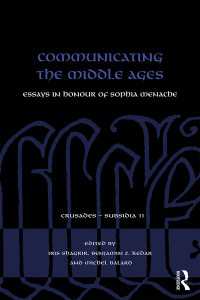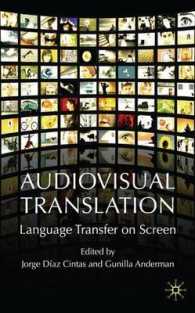- ホーム
- > 洋書
- > 英文書
- > Religion / Ethics
Full Description
Using a commentary on the influential text, the Mañjuśrī-nāmasaṃgīti, 'The Chanting of the Names of Mañjuśrī', this book deals with Buddhist tantric meditation practice and its doctrinal context in early-medieval India. The commentary was written by the 8th-9th century Indian tantric scholar Vilāsavajra, and the book contains a translation of the first five chapters. The translation is extensively annotated, and accompanied by introductions as well as a critical edition of the Sanskrit text based on eight Sanskrit manuscripts and two blockprint editions of the commentary's Tibetan translation.
The commentary interprets its root text within an elaborate framework of tantric visualisation and meditation that is based on an expanded form of the Buddhist Yoga Tantra mandala, the Vajradhātu-maṇḍala. At its heart is the figure of Mañjuśrī, no longer the familiar bodhisattva of wisdom, but now the embodiment of the awakened non-dual gnosis that underlies all Buddhas as well their activity in the cosmos.
The book contributes to our understanding of the history of Indian tantric Buddhism in a period of significant change and innovation. With its extensively annotated translation and lengthy introductions the book is designed to appeal not only to professional scholars and research students but also to contemporary Buddhists.
Contents
Part 1: Introductions
Overview
1. Contexts
2. Vilâsavajra: locating the NMAA's author
3. The Nâmasaṃgîti
4. Vilâsavajra's NMAA: overviews and remarks
5. The NMAA's maṇḍala in Himalayan Art
Part 2: Vilâsavajra's Nâmamantrârthâvalokinî:
an annotated translation of chapters 1-5
Conventions in the translation
Chapter 1: On 'The Request for Instruction'
Chapter 2: On 'The Reply'
Chapter 3: On 'The Survey of the Six Families'
Chapter 4: On 'The Method of Awakening According to the Mâyâjâla'
Chapter 5: On 'The Vajradhâtu-Mahâmaṇḍala of Bodhicittavajra' Part III: Sanskrit Edition
Materials and Methods
1. Sigla
2. Manuscripts
3. Method of Editing
4. Stemma Codicum
5. The Tibetan Translation of the NMAA
Critical Edition of Vilâsavajra's Nâmamantrârthâvalokinî:
Chapters 1-5
Adhikâra 1
Adhikâra 2
Adhikâra 3
Adhikâra 4
Adhikâra 5
Textual notes
Insignificant variants
Textual collation to establish the stemma codicum Appendices
Appendix 1. Works and authors cited in the NMAA
Appendix 2. Saṃvara, Cakrasaṃvara and Ṣaṭprajñânaya-
saṃvara citations
Appendix 3. NMAA colophons
Appendix 4. NMAA manuscripts:
-

- DVD
- ザ・スナイパー 孤高の男
-

- 洋書電子書籍
- Communicating the M…






